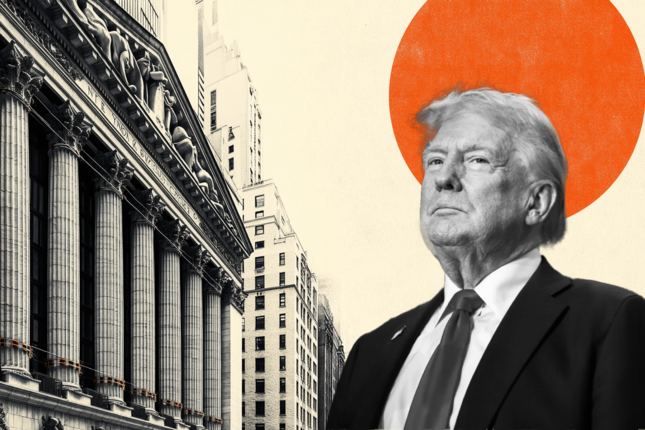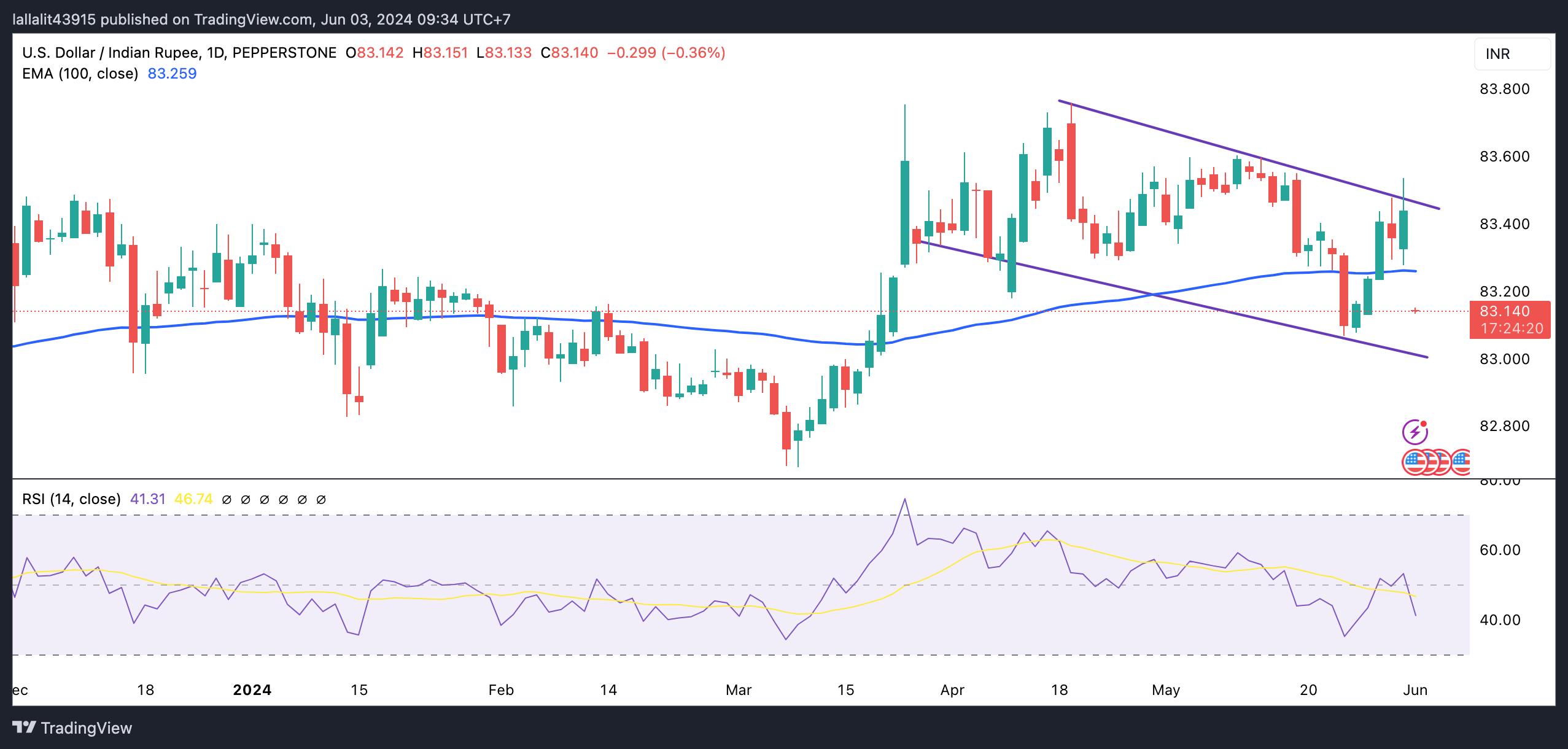Most recent article: 2024 Indian election: Continuity expected as Modi looks set to win third term
- Indian Rupee rebounds on Monday on the softer USD.
- The Indian HSBC Manufacturing PMI dropped to 57.5 in May from 58.4 in April.
- The success of Narendra Modi's (BJP) third-term election might boost the INR.
- The final reading on Indian and US Manufacturing PMI for May will be in the spotlight on Monday.
Indian Rupee (INR) recovers on Monday amid the weaker US dollar (USD). On Friday, the INR closed the week with its worst weekly performance in over two months, pressured by month-end USD demand from importers. However, the decline of the INR might be limited as the Reserve Bank of India (RBI) is likely to intervene in the local currency from depreciation. The recent economic data showed that India’s Manufacturing Purchasing Managers Index (PMI) for May came in weaker than expected, dropping to 57.5 from 58.4 in April.
However, the downbeat Indian PMI data had little to no impact on the INR as investors await India's general election outcome, with vote counting on June 4. Analysts expect the Indian Rupee to rally this week as exit polls revealed Prime Minister Narendra Modi's Bharatiya Janata Party would win a third term.
On the US docket, the ISM Manufacturing PMI will be released. The stronger-than-expected reading might dampen the expectation of the Federal Reserve (Fed) rate cut this year and boost the Greenback.
Daily Digest Market Movers: Indian Rupee gains momentum ahead of India's general election result
- Indian equity benchmark indices opened at a record high on Monday with the Nifty 50 up 3.58% or 807.20 points higher at 23,337.70 and Sensex up 2621.98 points, or 3.55% higher at 76,583.30, per the Indian Express.
- The Indian rupee should gain "as we will see dollar inflows on foreign funds buying domestic equities and debt," said HDFC Securities FX research analyst, Dilip Parmar.
- Most exit polls projected the governing NDA would win a two-thirds majority in the 543-member lower house of parliament, where 272 is required for a simple majority.
- The 10-year Indian government bond yield closed Friday at 6.9809%, marking the sixth straight weekly decline and having its biggest monthly loss in four years.
- The US Personal Consumption Expenditures (PCE) Price Index came in as expected, advancing 0.3% on a monthly basis in April and rising 2.7% on a yearly basis.
- The Core PCE, excluding the volatile food and energy, rose 0.2% MoM in April, compared to a 0.3% gain in March. On an annual basis, the core PCE price index climbed 2.8% for the third consecutive month.
- Personal Income rose 0.3% on a monthly basis in April, while Personal Spending grew by 0.2%.
- The US ISM Manufacturing PMI is expected to improve to 49.8 in May from 49.2 in April.
Technical analysis: USD/INR’s bullish outlook prevails
The Indian Rupee trades stronger on the day. The USD/INR pair keeps the bullish vibe above the key 100-day Exponential Moving Average (EMA) on the daily timeframe. The upward momentum is supported by the 14-day Relative Strength Index (RSI), which stands around 55.0, supporting the buyers for the time being.
A decisive break above a descending trend channel that has been established since mid-April at 83.40 will see a rally to 83.54 (high of May 13), followed by 83.72 (high of April 17), and finally at 84.00 (psychological mark).
On the flip side, the 100-day EMA around 83.21 acts as an initial support level for USD/INR. The key contention level to watch is the 83.00 round figure, A breach of the mentioned level could expose 82.78 (low of January 15).
US Dollar price today
The table below shows the percentage change of US Dollar (USD) against listed major currencies today. US Dollar was the weakest against the Euro.
| USD | EUR | GBP | CAD | AUD | JPY | NZD | CHF | |
| USD | -0.01% | 0.06% | 0.17% | 0.23% | 0.05% | 0.18% | 0.07% | |
| EUR | 0.01% | 0.07% | 0.18% | 0.24% | 0.06% | 0.18% | 0.08% | |
| GBP | -0.06% | -0.07% | 0.11% | 0.16% | 0.00% | 0.12% | 0.01% | |
| CAD | -0.17% | -0.18% | -0.11% | 0.06% | -0.11% | 0.01% | -0.09% | |
| AUD | -0.23% | -0.23% | -0.16% | -0.05% | -0.16% | -0.04% | -0.15% | |
| JPY | -0.05% | -0.05% | 0.02% | 0.11% | 0.15% | 0.12% | 0.02% | |
| NZD | -0.16% | -0.19% | -0.12% | 0.02% | 0.06% | -0.11% | -0.09% | |
| CHF | -0.08% | -0.09% | -0.02% | 0.09% | 0.14% | -0.02% | 0.10% |
The heat map shows percentage changes of major currencies against each other. The base currency is picked from the left column, while the quote currency is picked from the top row. For example, if you pick the Euro from the left column and move along the horizontal line to the Japanese Yen, the percentage change displayed in the box will represent EUR (base)/JPY (quote).
Indian Rupee FAQs
The Indian Rupee (INR) is one of the most sensitive currencies to external factors. The price of Crude Oil (the country is highly dependent on imported Oil), the value of the US Dollar – most trade is conducted in USD – and the level of foreign investment, are all influential. Direct intervention by the Reserve Bank of India (RBI) in FX markets to keep the exchange rate stable, as well as the level of interest rates set by the RBI, are further major influencing factors on the Rupee.
The Reserve Bank of India (RBI) actively intervenes in forex markets to maintain a stable exchange rate, to help facilitate trade. In addition, the RBI tries to maintain the inflation rate at its 4% target by adjusting interest rates. Higher interest rates usually strengthen the Rupee. This is due to the role of the ‘carry trade’ in which investors borrow in countries with lower interest rates so as to place their money in countries’ offering relatively higher interest rates and profit from the difference.
Macroeconomic factors that influence the value of the Rupee include inflation, interest rates, the economic growth rate (GDP), the balance of trade, and inflows from foreign investment. A higher growth rate can lead to more overseas investment, pushing up demand for the Rupee. A less negative balance of trade will eventually lead to a stronger Rupee. Higher interest rates, especially real rates (interest rates less inflation) are also positive for the Rupee. A risk-on environment can lead to greater inflows of Foreign Direct and Indirect Investment (FDI and FII), which also benefit the Rupee.
Higher inflation, particularly, if it is comparatively higher than India’s peers, is generally negative for the currency as it reflects devaluation through oversupply. Inflation also increases the cost of exports, leading to more Rupees being sold to purchase foreign imports, which is Rupee-negative. At the same time, higher inflation usually leads to the Reserve Bank of India (RBI) raising interest rates and this can be positive for the Rupee, due to increased demand from international investors. The opposite effect is true of lower inflation.
Information on these pages contains forward-looking statements that involve risks and uncertainties. Markets and instruments profiled on this page are for informational purposes only and should not in any way come across as a recommendation to buy or sell in these assets. You should do your own thorough research before making any investment decisions. FXStreet does not in any way guarantee that this information is free from mistakes, errors, or material misstatements. It also does not guarantee that this information is of a timely nature. Investing in Open Markets involves a great deal of risk, including the loss of all or a portion of your investment, as well as emotional distress. All risks, losses and costs associated with investing, including total loss of principal, are your responsibility. The views and opinions expressed in this article are those of the authors and do not necessarily reflect the official policy or position of FXStreet nor its advertisers. The author will not be held responsible for information that is found at the end of links posted on this page.
If not otherwise explicitly mentioned in the body of the article, at the time of writing, the author has no position in any stock mentioned in this article and no business relationship with any company mentioned. The author has not received compensation for writing this article, other than from FXStreet.
FXStreet and the author do not provide personalized recommendations. The author makes no representations as to the accuracy, completeness, or suitability of this information. FXStreet and the author will not be liable for any errors, omissions or any losses, injuries or damages arising from this information and its display or use. Errors and omissions excepted.
The author and FXStreet are not registered investment advisors and nothing in this article is intended to be investment advice.
Recommended content
Editors’ Picks

EUR/USD recovers toward 1.0400 as USD rally loses steam
EUR/USD recovers from daily lows toward 1.0400 in the American session on Tuesday. Following the earlier rally, the USD struggles to preserve its strength as the bullish opening in Wall Street's main indexes point to an improving risk mood.

GBP/USD stays below 1.2300 after UK employment data
GBP/USD rebounds from session lows but remains below 1.2300 in the second half of the day on Tuesday. The US Dollar clings to modest gains but finds it difficult to gather further bullish momentum as the impact of Trump's tariff threats fade.

Gold climbs to fresh multi-month high above $2,730
Gold gathers bullish momentum and trades at its highest level since early November above $2,730 on Tuesday. The benchmark 10-year US Treasury bond yield is down more than 1% below 4.6% following US President Trump's tariff threats, helping XAU/USD push higher.

Bitcoin fails to sustain the $109K mark after Trump’s inauguration
Bitcoin’s price steadies above the $102,000 mark on Tuesday after reaching a new all-time high of $109,588 the previous day. Santiment’s data shows that BTC prices quickly corrected, as social media showed major greed and FOMO among the traders in Bitcoin after President Donald Trump’s inauguration.

Prepare for huge US trade changes as Trump goes America first
You can be sure that big changes are coming as far as US trade is concerned, even if we didn't get any new tariffs on President Trump's first day in office. A comprehensive investigation into US trade relationships was initiated via a memorandum. China, Canada, and Mexico are clearly in the immediate firing line.

Trusted Broker Reviews for Smarter Trading
VERIFIED Discover in-depth reviews of reliable brokers. Compare features like spreads, leverage, and platforms. Find the perfect fit for your trading style, from CFDs to Forex pairs like EUR/USD and Gold.
